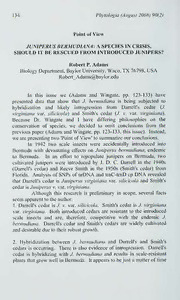
Juniperus bermudiana; A species in crisis, should it be rescued from introduced junipers? PDF
Preview Juniperus bermudiana; A species in crisis, should it be rescued from introduced junipers?
134 Phytologia (August 2008) 90(2) Point ofView JUNIPERUSBERMUDIANA: A SPECIES IN CRISIS, SHOULD IT BE RESCUED FROM INTRODUCED JUNIPERS? Robert P. Adams Biology Department, Baylor University, Waco, TX 76798, USA [email protected] In this issue we (Adams and Wingate, pp. 123-133) have presented data that show that J. bermudiana is being subjected to hybridization and likely introgression from Darrell's cedar (J. virgifiiaua var. silicicola) and Smith's cedar (J. v. var. virginiana). Because Dr. Wingate and I have differing philosophies on the conservation of species, we decided to omit conclusions from the previous paper (Adams and Wingate, pp. 123-133, this issue). Instead, we are presenting two 'Point ofView' to summarize ourconclusions. In 1942 two scale insects were accidentally introduced into Bermuda with devastating effects on Jimipenis bermudiana, endemic to Bermuda. In an effort to repopulate junipers on Bemiuda, two cultivated junipers were introduced by J. D. C. Darrell in the 1940s (Darrell's cedar) and Reeve Smith in the 1950s (Smith's cedar) from Florida. Analysis ofSNPs ofnrDNA and trnC-tmD cp DNA revealed that Darrell's cedar is Juniperus virginiana var. silicicola and Smith's cedar isJuniperus v. var. virginiana. Although this research is preliminary in scope, several facts seem apparent to the author: 1. Darrell's cedar is J. v. var. silicicola. Smith's cedar is J. virginiana var. virginiana. Both introduced cedars are resistant to the introduced scale insects and are, therefore, competitive with the endemic J. bermudiana. Darrell's cedar and Smith's cedars are widely cultivated and desirable due to their robust growth. 2. Hybridization between J. bermudiana and Darrell's and Smith's cedars is occurring. There is also evidence ofintrogression. Darrell's cedar is hybridizing with J. bermudiana and results in scale-resistant plants that grow well in Bermuda. It appears to bejust a matter oftime Phytologia (August2008) 90(2) 135 until there will be no genetically pure individuals ofJ. benmidiana on Bennuda. 3. Many residents of Bermuda apparently do not recognize the differences between their endemic juniper and the introduced juniper species. Therefore, it would seem unlikely that public interest will develop in removing the introducedjunipers and conserving the native junipers. 4. Although J. benmidiana has gone through a tremendous genetic bottleneck, trees were found that were in good health and appear to have resistance to the scale insects. The effects ofthe scale insects are not completely devastating as many very old, large trees remain cultivated in cemeteries and in private yards. Another significant factor has been the introduction of several unrelated, weedy tree species that are very aggressive and compete for space and nutrients. Can J. benmidiana germplasm be conserved in Bermuda? Yes. Will the germplasm be conserved? That is a difficult projection to make. It will take a massive effort to remove Darrell's and Smith's cedars from Bermuda. Some Darrell's cedar trees are now 50-60 years old and prized by residents (particularly along Cedar St. in Hamilton, where deadJ. benmidiana trees have been replaced with scale resistant Darrell's cedars). Because hybridization is occurring, suspectedhybrids and introgressive plants would also need to be removed. Removing all such cedars will likely be opposedby residents. Can J. bermudiana germplasm be conserved in other locations? In the mid-19th century, seeds of J. benmidiana from Bermuda (via Kew Gardens) were taken to St. Helena and Ascension Islands in the south Atlantic ocean, between Africa and Brazil. They were planted to produce timber trees and J. benmidiana has thrived on these islands (Phillip Ashmole and Andrew Darlow, Invasive Species Officer, St. Helena Island, and Susanna Musick, Head, Conservation Dept., Ascension Island, pers. comm.). However,y. virginiana has also been introduced on St. Helena (Phillip Ashmole, pers. comm.) so there is the potential for hybridization. These islands, due to their extreme geographic isolation, may be a repository for J. benmidiana germplasm. 136 Phytologia (August2008) 90(2) Botanic gardens hold promise for ex situ conservation of J. bermudiana, but because nearly all botanic gardens grow J. virginiana, collecting seed fromJ. bermudiana might result in hybrid plants. Note that bothJ. bermudiana andJ. virginiana are dioecious species. Thus, pollination ofa femaleJ. bermudiana from a maleJ. virginiana is quite likely (particularly if no male J. bermudiana is nearby). The safest method of propagation would be by taking cuttings from J. bermudiana. Should we care if a species goes extinct? Extinction is the nonn; survival is the exception for species throughout geologic time. Yet, there seems to be a common philosophy among humans that we should not hasten the extinction ofspecies. There is also a philosophy that we are part of the environment and the evolutionary mix, so let "nature take its course". However, that philosophy can degenerate into a "live today; nature will take care oftomorrow". There are, however, practical reasons to conserve species. First, biodiversity in our ecosystem generally leads to stability and a stable environment is mostly to our benefit. Second, species possess a unique genome with gemiplasm that has co-evolved with nature. They contain a storehouse of phytochemicals that have biological activity such as anti-cancer, anti-malaria, anti-microbial, etc. that act as lead structure compounds for drug development. Third, species contain many allelic fonns of genes that can provide important germplasm resources for breeding and genetic engineering. For example, the genetic resources of the wild wheats from central Asia are constantly being utilized in modem wheat breeding to develop agronomic characteristics such as anti-lodging, seed shatter resistance, insect and disease resistance, to name but a few. Without the conservation ofthe wild species, breeders would very limited. Fourth, species are critical for phylogenetic and evolutionary research. One can only imagine the impact ofhaving access to some ofthe extinct species' genomes in our present day studies ofevolution. In summary, the preservation of a seemingly 'insignificant' species can have very practical significance. However, whether the cost of preservation in situ or ex situ is acceptable depends on many social norms that are outside my expertise.
